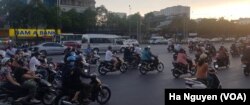Any traveler to Vietnam will be familiar with the experience: A trip here is not complete until the traveler ventures to cross the intimidating roads that heave with motorbikes, only to find that drivers will weave around the pedestrian and that there is in fact some order in the seeming chaos of the street.
Vietnam is the land of the motorbike. Google Maps even introduced a feature for two-wheel commuters in the country last year, giving them trip times and road tolls specific to motorbikes.
So can Vietnam’s two biggest cities really ban the transport on which its 100 million people depend on a daily basis?
Municipal authorities have proposed a motorbike ban in parts of Hanoi and Ho Chi Minh City. This proposal has cropped up from time to time over the years, and now is one of those times. The idea has sparked a debate about pollution, traffic jams, urban planning, and the fairest way to get people where they need to go as the Vietnamese economy rapidly grows, industrializes, and urbanizes.
Supporters of a no-go area for motorbikes say restrictions are needed to cut pollution and congestion. But opponents say the masses have no alternative, as cars are pricey and public transit is limited.
“Hanoi is just now in the process of developing the idea,” the Ministry of Transport of Vietnam’s official newspaper quoted its minister, Nguyen Ngoc Dong, as saying recently. “There are still a lot of issues that need to be researched, assessed, and analyzed before making a final plan.”
Congestion and pollution
The idea is to prohibit motorbikes during the busiest parts of the day, or in the busiest parts of the city, most likely downtown. There is no arguing that the streets are getting cramped. Ho Chi Minh City has ballooned to as many as 13 million residents. And air quality is no doubt worsening. Pollution levels, as measured by particulate matter, occasionally surpass those of China's and India’s urban centers.
So proponents of a ban argue that if Chinese cities could do it, so could they. Crowded metropolises from Beijing to Mexico City also have imposed partial curbs on cars, such as allowing only ones with odd-number license plates to drive on one day, even numbers on the next. Other places like Stockholm have been able to push vehicles out of pedestrian zones.
But the difference is that, unlike those places, Vietnamese cities do not have enough public transit to replace the motorbike. Projects to build subway systems have been delayed repeatedly, and commuters do not want to take buses when motorbikes are faster, more convenient than transferring from one bus to another, and still cheap. Vespa maker Piaggio Vietnam said a motorbike ban could push people to use cars, which would not help solve the pollution and congestion problems.
“We believe that to meet those objectives, simply banning motorbikes is a radical and not effective solution,” Enrico Bruni, the company's head of finance for Asia, said at a business conference last month.
Traffic Sensors
Better to focus on educating the public about these problems, and controlling vehicle quality by regulating emissions, he said. Others suggest that Vietnamese officials should try to experiment with ways to redistribute traffic, such as through staggered work times, or through smart sensors that detect when streets are getting jammed and reroute drivers accordingly. One ride hailing app maker said it could provide traffic data to help city planners.
It would not be easy to curtail two-wheeled vehicles in a place where so many of the iconic images that identify Vietnam contain a motorbike or two. It is not uncommon to see a family of five pile on to the two wheels. Delivery people transport cargo on the back of their bikes, from giant hogs to dining tables. Tourists hop on behind driver guides for Vespa food tours. Middle age war veterans who can’t find work turn their motorbikes into taxis.
The vehicle is one example of how much the communist country has changed. Many locals are old enough to remember a time when they would have been lucky even to own a bicycle. But today nearly everyone can afford a motorbike, which costs as little as a few hundred dollars. Vietnam is the fourth biggest market for motorbikes in the world, after China, India, and Indonesia, all of which have at least double the population of Vietnam.
Affordability is one reason that critics say a motorbike ban would more heavily burden the poor, who rely on motorbikes, in favor of the wealthy who have cars. This is a country where people will jump on a bike to drive one block. Limited sidewalks and temperatures of 40 degrees Celsius do not always make walking feasible.
That is not to say partial restrictions do not work. Ho Chi Minh City started limiting vehicles on the downtown street of Nguyen Hue several years ago. Despite the initial inconvenience, residents have come to enjoy the pedestrian street, which has now become a popular public space.





